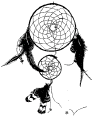At this point the Ojibway tribe again separated into
two divisions, which we will designate as the Northern and Southern. The
Northern division formed the least numerous body, and consisted chiefly of
the families claiming as Totems the reindeer, lynx, and pike. They proceeded
gradually to occupy the north coast of Lake Superior, till they arrived at
the mouth of Pigeon River (Kah-mau-a-tig-wa-aug). From this point they have
spread over the country they occupy at the present day along the British and
United States line, and north, far into the British possessions. A large
band early occupied and formed a village at Rainy Lake. Here they first came
in contact with the Assineboins (a tribe of seceding Dakotas), and from this
point, after entering into a firm and lasting peace with the Assineboins and
Knis-te-nos, they first joined their brethren of the Southern division in
their wars against the fierce Dakotas. This band has to this day retained
the cognomen of Ko-je-je-win-in-e-wug, from the numerous straits, bends, and
turnings of the lakes and rivers, which they occupy.
A large body of this Northern division residing immediately
on the north shores of the Great Lake, at Grand Portage and Thunder Bay, and
claiming the Totem of the Ke-nouzhay or Pike, were formerly denominated
O-mush-kas-ug. Tradition says that at one time their fellow-Ojibways made
war on them. This war was brought about by persons belonging to the Pike
family murdering some members of the Marten Totem family. It was but the
carrying out of their custom of "blood for blood." It was neither very
deadly nor of long duration, and to illustrate its character more fully, I
will introduce the following traditional anecdote:--
A party consisting of warriors belonging to the Martin family was at one
time collected at Fond du Lac. They proceeded on the war-path against the
family of the Omush-kas, living on the north shore of the Great Lake, for
this family had lately spilled their blood. They discovered a single wigwam
standing on the sandy shores of the lake, and the Martens, having stealthily
approached, raised the war-whoop, and as was the custom in battle (to show
their greater manhood), they threw off every article of clothing, and thus,
perfectly naked, rushed furiously to the attack. The Omush-kas, head of the
family occupying the threatened lodge, was busy arranging his fishnet and
not aware that war had been declared, he paid no attention to his yelling
visitors, but calmlycontinued his peaceful occupation.
One of the Martens, rushing into the lodge, and, throwing
his arms about him, exclaimed, "Ene-ne-nin-duk-o-nah" (a man I hold),
meaning that he took him captive.
The simple Omushkas, looking up, merely remarked, "Let me
go; you are tangling my net." Still the Marten, keeping his hold, more
loudly exclaimed, "Ene-ne-nin-rink-o-nab." The Omushkas, now perceiving his
nakedness, grasped a sensitive part of his person, in turn jokingly
exclaimed, "Nin-sah-eta-in-ne-ne-nin-duk-o-nah" ("'tis only I who truly hold
a man"), and the simple man continued to consider the attack as a mere
farce. The war-club, however, of the enraged Marten now descended with
fearful force on his head, and he died exclaiming, "Verily they are killing
me."
A considerable body of the Northern Ojibways is
denominated by their fellow-tribesmen Sug-wau-dug-ah-win-in-e-wug (men of
the thick firewood), derived from the interminable forests of balsam,
spruce, pine, and tamarac trees which cover their hunting-grounds. Their
early French discoverers named them "Bois Forts," or Hardwoods.
Another section forming the most northern branch of this
tribe is denominated Omushke-goes (Swamp-people), derived also from the
nature of the country they occupy.
The Northern division, which comprises these different
sections, having been separated from the main body of the tribe forming the
Southern division, now upwards of eight generations, a difference (though
not a radical one), has become perceptible in their common language. This
consists mostly in the pronunciation, and so slight is the difference in
idiom that one good interpreter, speaking the language of each division, may
suffice for both.
The characteristics, also of the northern section of the
tribe, differ materially in some important respects from those of their
southern and western brethren. Not having been opposed by enemies in the
course of their northern emigration, they are consequently not warlike, and
the name of Waub-ose (Rabbit), is often applied to them by their more
warlike fellows, on account of their mild and harmless disposition.
At the partition of the Ojibway tribe into two divisions,
at Sault Ste. Marie, the main body pressed their way gradually up along the
southern shores of Lake Superior. They made a temporary stand at Grand
Island, near the Pictured Rocks, again at L'Anse Bay, or as they more
euphoniously name it, We-qua-dong. This grand division consisted principally
of the Crane Totem family, the Bear, the Catfish, the Loon, and the allied
Marten and Moose clans. These great families with their several branches
form at least eight-tenths of the whole Ojibway tribe.
The Cranes claim the honor of first having pitched their
wigwams, and lighted the fire of the Ojibways, at Shaug-ah-waum-ik-ong, a
sand point or peninsula lying two miles immediately opposite the Island of
La Pointe. This fact is illustrated by the following highly allegorical and
characteristic tradition:--
As a preliminary remark, it is necessary to state that there exists quite a
variance between three or four of the principal Totems, as to which is
hereditarily entitled to the chief place in the tribe.
At a council (in which the writer acted as interpreter),
held some years ago at La Pointe, between the principal chiefs of the
Ojibways and the United States Government Agent, the following allegory was
delivered by an old chief named Tug-waug-aun-ay, in answer to the mooted
question of "who was the hereditary chief of La Pointe?"
Ke-che-wash-keenh (Great Buffalo), the grandson of the
celebrated chief Au-daig-we-os (mentioned in Schoolcraft's works), head of
the Loon Totem clan, was at this time, though stricken with years, still in
the prime of his great oratorical powers.
On this occasion he opened the council by delivering a
most eloquent harangue in praise of his own immediate ancestors, and
claiming for the Loon family the first place and chieftainship among the
Ojibways. After he had finished and again resumed his seat, Tug-waug-aun-ay,
the head chief of the Crane family, a very modest and retiring man, seldom
induced to speak in council, calmly arose, and gracefully wrapping his
blanket about his body, leaving but the right arm free, he pointed toward
the eastern skies, and exclaimed: "The Great Spirit once made a bird, and he
sent it from the skies to make its abode on earth. The bird came, and when
it reached half way down, among the clouds, it sent forth a loud and far
sounding cry, which was heard by all who resided on the earth, and even by
the spirits who make their abode within its bosom. When the bird reached
within sight of the earth, it circled slowly above the Great Fresh Water
Lakes, and again it uttered its echoing cry. Nearer and nearer it circled,
looking for a resting place, till it lit on a hill overlooking Boweting
(Sault Ste. Marie); here it chose its first resting place, pleased with the
numerous white fish that glanced and swam in the clear waters and sparkling
foam of the rapids. Satisfied with its chosen seat, again the bird sent
forth its loud but solitary cry; and the No-kaig (Bear clan), A-waus-e-wug
(Catfish), Ah-auh-wauh-ug (Loon), and Mous-o-neeg (Moose and Marten clan),
gathered at his call. A large town was soon congregated, and the bird whom
the Great Spirit sent presided over all.
"Once again it took its flight, and the bird flew slowly
over the waters of Lake Superior. Pleased with the sand point of
Shaug-ah-waum-ik-ong, it circled over it, and viewed the numerous fish as
they swam about in the clear depths of the Great Lake. It lit on
Shaug-ah-waum-ik-ong, and from thence again it uttered its solitary cry. A
voice came from the calm bosom of the lake, in answer; the bird pleased with
the musical sound of the voice, again sent forth its cry, and the answering
bird made its appearance in the wampum-breasted Ah-auh-wauh (Loon). The bird
spoke to it in a gentle tone, 'Is it thou that gives answer to my cry?' The
Loon answered, 'It is I.' The bird then said to him, 'Thy voice is music--it
is melody--it sounds sweet in my ear, from henceforth I appoint thee to
answer my voice in Council.'
"Thus," continued the chief, "the Loon became the first in
council, but he who made him chief was the Bus-in-aus-e (Echo Maker), or
Crane. These are the words of my ancestors, who, from generation to
generation, have repeated them into the ears of their children. I have
done."
The old man took his seat ill silence, and not a chief in
that stricken and listening crowd arose to gainsay his words. All understood
the allegory perfectly well, and as the curling smoke of their pipes arose
from the lips and nostrils of the quiet listeners, there ascended with it
the universal whisper, "It is true; it is true."
As an explanation of the figures used in the above
traditional allegory, we will add, that the crane, commonly named in the
Ojibway language Uj-e-jauk, is the symbol or totem of a large section of the
tribe. This bird loves to soar among the clouds. and its cry can be heard
when flying above, beyond the orbit of human vision. From this "far sounding
cry" the family who claim it as their totem derive their generic name of
Bus-in-aus-e-wug (Echo Makers). This family claim, by this allegory, to have
been the first discoverers and pioneer settlers at Sault Ste. Marie, and
again at Pt. Shaug-ah-waum-ik-ong.
The Loon is the Totem also of a large clan. This bird is
denominated by the Ojibways, Mong, but the family who claim it as their
badge, are known by the generic name of Ah-auh-wauh, which is derived by
imitating its peculiar cry. This family claim the hereditary first
chieftainship in the tribe, but they cannot substantiate their pretensions
further back than their first intercourse with the old French discoverers
and traders, who, on a certain occasion, appointed some of their principal
men as chiefs, and endowed them with flags and medals. Strictly confined to
their own primitive tribal polity, the allegory of the Cranes cannot be
controverted, nor has it ever been gainsaid.
go to conclusion of chapter 4
1
- 2
- 3
- 4
- 5
- 6
- 7
- 8
- 9
- 10
11
- 12
- 13
- 14
- 15
- 16
- 17
- 18
- 19
- 20
21
- 22
- 23
- 24
- 25 - 26 - 27 - 28 - 29 - 30
White Eagle Soaring: Dream Dancer of the 7th Fire







 Get
a course to promote your business online, explode your sales
Get
a course to promote your business online, explode your sales Get
software to promote your business online in less time
Get
software to promote your business online in less time Get
software to streamline your business and run it hands free.
Get
software to streamline your business and run it hands free.